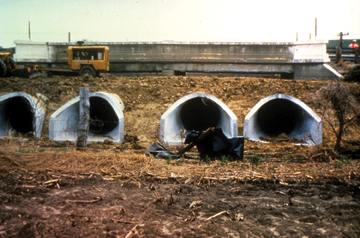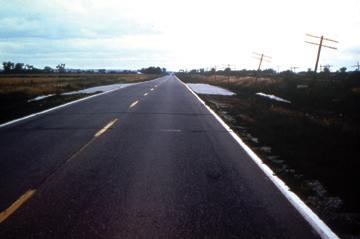Fly Ash Facts for Highway Engineers
Chapter 5 - Fly Ash in Flowable Fill
General
Flowable fill includes a family of products usually consisting of water, fly ash, portland cement, and sometimes, coarse or fine aggregates, or both. Flowable fill is an engineered, strength controlled, fill material that is self-leveling, self-compacting and non-settling. This material is also known as:
- Controlled density fill (CDF)
- Controlled low strength material (CLSM)
- Flowable fly ash
- High slump fly ash grout
- Lean concrete slurry
- Lean mix backfill
- Unshrinkable fill
Figure 5-1: Flowable fill used in a utility trench application.
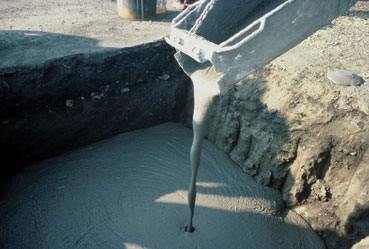
Flowable fill mixtures make up a class of engineering materials having characteristics and uses that overlap those of a broad range of traditional materials including compacted soil, soil-cement, and concrete. Consequently, flowable fills are proportioned, mixed, and delivered in a form that resembles a very workable concrete; and they provide for an in-place product that is equivalent to a high-quality compacted soil without the use of compaction equipment and related labor.
Virtually any coal fly ash can be used in flowable fill mixes. The fly ash does not have to meet AASHTO M 295 (ASTM C 618) specification requirements as a concrete admixture to be suitable for use in flowable fill, even fly ash with high LOI or carbon content is suitable. The individual specifying agencies may have applicable specifications or regulations regarding fly ash flowable fill. Regardless of the type of handling practices, fly ash for flowable fill can be used in a dry or moisture conditioned form. Fly ash recovered from storage ponds has been used successfully. Flowable fill mixes using high-calcium fly ash may not require any cement. Mix design and performance testing are typically prepared to determine the suitability of a fly ash and other ingredients for the specific flowable requirements.
Upon comparison, flowable fill materials usually offer an economic advantage over the cost of placing and compacting earthen backfill materials. Depending on the job conditions and costs involved, significant savings are possible. The closer the project location is to the source of the flowable fill, the greater the potential cost savings. Flowable fill also becomes more economical than conventional earthen backfill if shoring and/or sloping of the trench is necessary for worker safety within the excavated area. With flowable fill, workers need not be in the excavation, resulting in cost savings from less excavation and no shoring.
Figure 5-2: Flowable fill eliminates the need for manual compaction.
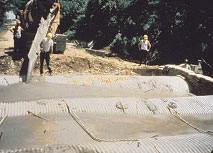
Figure 5-3: Flowable fill can be used to backfill very narrow trenches.
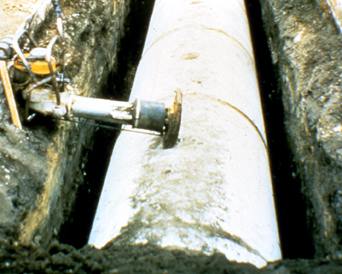
Mix Design and Specification Requirements
Flowable fill mixes typically contain fly ash, portland cement and water. Other cementing compounds (e.g., Class C ash, cement kiln dust, etc.) may be used in lieu of portland cement in certain applications. Filler materials such as bottom ash, sand (including some foundry sands) or other aggregates can also be used in the mix. The flowable character of these mixtures derives from the spherical particle shape of fly ash or from a distribution of spherical and irregular particle shapes and sizes in fly ash and sand combinations when mixed with enough water to lubricate the particle surfaces.
Fly ash can be a major ingredient in a flowable fill mix. It can be less expensive than sand. Flowable fills can use non-concrete grade fly ash, which may be obtained at a reduced cost. However, when sand is more economical, fly ash can be limited to 300 or fewer kilograms per cubic meter (500 or fewer pounds per cubic yard). Water requirements for mixture fluidity will depend on the surface parameters of all solids in the mixture, however, a range of 250 to 400 liters per cubic meter (50 to 80 gallons per cubic yard) would satisfy most materials combinations. Portland cement is added, typically in quantities from 30 to 60 kilograms per cubic meter (50 to 100 pounds per cubic yard) to provide a weak cementitious matrix.
The two basic types of flowable fill mixes are high fly ash content and low fly ash content. The high fly ash content mixes typically contain almost all fly ash with a small percentage of portland cement and enough water to make the mix flowable. The low fly ash content mixes contain a high percentage of fine aggregate or filler material (usually sand), a low percentage of fly ash sufficient to help the sand particles flow, a small percentage of portland cement (similar to that used in high fly ash content mixes), and enough water to make the mix flowable.
ACI Committee 229 has designated low fly ash content mixes that contain high percentages of fine aggregate as CLSM. According to the ACI definition, CLSM has an upper compressive strength limit of 8,300 kPa (1,200 psi), however, strengths can be designed as low as 345 kPa (50 psi). Most flowable fill mixes are designed to achieve a maximum strength of 1,000 to 1,400 kPa (150 to 200 psi) so as to allow for excavation at a later time. It is important to remember that flowable fill mixes with an ultimate strength in the 345 to 480 kPa (50 to 70 psi) range have at least two to three times the bearing capacity of well-compacted earthen backfill material.
Usually, flowable fill mix designs are proportioned based on the percentage of fly ash, on a dry weight basis. The high fly ash content mixes normally contain 95 percent fly ash and 5 percent portland cement. In some areas, self-cementing fly ash accounts for 100 percent of the cementitious material. Because the low fly ash content mixes contain an additional ingredient (sand or filler), there is a much broader range of mix proportions. Some typical mix designs for high and low fly ash content mixes are included in Tables 5-1 and 5-2. The most important physical characteristics of flowable fill mixtures are: strength development, flowability, hardening time, and bleeding/subsidence.
| Component | Range | Mix Design | ||
|---|---|---|---|---|
| kg/m3 | (lb/yd3) | kg/m3 | (lb/yd3) | |
| Fly Ash | 949 to 1,542 | (1,600 to 2,600) | 1,234 | (2,080) |
| Cement | 47 to 74 | (80 to 125) | 62 | (104) |
| Added Water | 222 to 371 | (375 to 625) | 247 | (416)* |
| 1,543 | (2,600) | |||
*Equal to 189 liters (50 gallons)
| Component | Range | Mix Design | ||
|---|---|---|---|---|
| kg/m3 | (lb/yd3) | kg/m3 | (lb/yd3) | |
| Fly Ash* | 119 to 297 | (200 to 500) | 178 | (300) |
| Cement | 30 to 119 | (50 to 200) | 59 | (100) |
| Sand | 1,483 to 12,780 | (2,500 to 3,000) | 1,542 | (2,600) |
| Added Water | 198 to 494 | (333 to 833) | 297 | (500)** |
| 2,076 | (3,500) | |||
* High calcium fly ash is used in lower amounts than low calcium fly ash.
**Equal to 227 liters (60 gallons)
Strength development. Strength development in flowable fill mixtures is directly related to the amount of cementitious material and water content. With low CaO (Class F) fly ashes, the cement content and water content relate directly to strength development. With high CaO (Class C) fly ashes, no cement may be required and strength is related directly to the fly ash and water content. Most high fly ash content mixes only require from three to five percent portland cement by dry weight of the fly ash to develop 28-day compressive strengths in the 345 to 1,000 kPa (50 to 150 psi) range. Long-term strength may gradually increase beyond the 28-day strength. Water content of mix also influences strength development. Water is added to achieve a desired flowability or slump. At a given cement content, increased water content usually results in a slight decrease in compressive strength development over time. With high air (greater than 20 percent) flowable fill mixtures, the water content is reduced and strength is limited by the presence of air voids.
Flowability. Flowability is basically a function of the water and entrained air content. The higher the water and air content, the more flowable the mix. It is usually desirable to make the mix as flowable as practical in order to take advantage of the self-compacting qualities of flowable fill. Typical flowable fill mixes with high air content are shown in Table 5-3.
| Component | Range | Mix Design | ||
|---|---|---|---|---|
| kg/m3 | (lb/yd3) | kg/m3 | (lb/yd3) | |
| Fly Ash | 119 to 297 | (200 to 500) | 160 | (350) |
| Cement | 30 to 119 | (50 to 200) | 30 | (50) |
| Sand | 1,483 to 1,780 | (2,500 to 3,000) | 1,365 | (2,300) |
| Water | 115 to 150 | (30 to 40) | 132 | (35) |
| Air Content, % | 20 to 30 | 20 to 30 | ||
Hardening time. Hardening time is directly related to the cement content. Typical high fly ash flowable fill mixes containing five percent cement achieve a sufficient set to support the weight of an average person in about three to four hours, depending on the temperature and humidity. Within 24 hours, construction equipment can move across the surface without any apparent damage. Some low fly ash flowable fill mixes containing high calcium fly ash have reportedly set sufficiently to allow street patching within one to two hours after placement.
Bleeding and subsidence. Bleeding and subsidence are possible in high fly ash flowable fill mixes with relatively high water contents (corresponding to a 254 mm/10-in slump). Evaporation of the bleed water and absorption into the surrounding soil often results in a subsidence of approximately 11 mm/m (1/8-in/ft) of depth of the fill. This shrinkage may occur laterally as well as vertically, but no additional shrinkage or long-term settlement of flowable fill occurs after initial set. Prior to hardening, flowable fill mixes are self-leveling.
Because the flowable fill is commonly obtained from ready-mixed concrete producers, quality control of the fill is easily maintained with the materials scales and metering devices already in use at the concrete plant. Delivery is usually by conventional ready-mix trucks. Flowable fill can also be pumped or placed by bucket, conveyor, or hose. It does not usually segregate even if dropped from considerable heights or pumped for long distances.
Applications of flowable fills include, but are not limited to: backfill for bridge abutments, culverts, and trenches; fill for embankments, bases, and subbases; bedding for slabs and pipes; insulating fill; fill for caissons and piles; and fill for abandoned storage tanks, shafts, and tunnels.
An important requirement for flowable fills in many applications is that they can be removed with ordinary excavation equipment. This means that compressive strength should be limited to 700 to 1,400 kPa (100 to 200 psi) with mechanical equipment and 345 kPa or less (50 psi) for manual excavation. Because of the combined concrete/soils technology associated with flowable mixtures, a variety of control tests have been applied to their use, including flowability as measured by a concrete slump cone, a flow cylinder, or a mortar flow cone and unit weight, as well as measures of compressive strength, bearing capacity, or penetration resistance (ACI 229R).
Figure 5-4: Bridge abutment backfill with flowable fill.
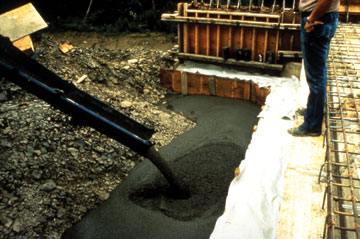
As with any construction application, quality control and quality assurance (QC/QA) of the materials and the mix are extremely important. Good QC/QA will take maximum advantage of the benefits of flowable fill.
Corrosion. Test methods developed to evaluate the potential for corrosion of metals in soil backfills can be used to evaluate the corrosion potential of flowable fills. ACI 229R describes several test methods specific to the material in contact with flowable fill.
Figure 5-5: Bridge replaced by culverts and flowable fill.
